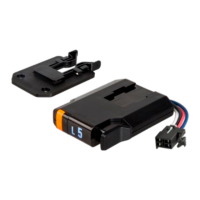CURTMFG.COM
•
PRODUCT SUPPORT: 877.287.8634
•
51126-INS-RA
•
PAGE 12
BENCH TEST
Note: If a quick plug pigtail is not available, push pins
can be used to make a direct connection to the female
terminals of the Discovery
™
quick plug housing.
Ensure that the brake control wires, quick plug wires,
push pins and test leads do not make contact with each other or any
other metal surface. Failure to do so may damage the brake controller.
Connect the module to the quick plug to provide accessible wires for
bench testing. Connect the white ground wire of the main module and
the ground wire of the bulb to the negative terminal of the 12V battery.
Leave the red brake input wire and blue output wire disconnected.
Connect the black battery wire of the module to the positive
terminal of the 12V battery. If the brake controller is wired properly
and the Discovery
™
is operational, the display will power on.
Parts Needed:
Brake Control Setup
1. Standard 1156 automotive bulb in a socket
2. Charged 12V battery
3. Alligator clip test leads OR wire and wire nuts
4. CURT #51515 / #51516 quick plug with pigtails OR push pins
TEST DRIVE & ADJUSTMENT
Both the gain and load can be adjusted to achieve smooth, firm stops.
Gain and load adjustments should only be made while stopped, with the
transmission in park or neutral, parking brake applied, foot off the brake
pedal and no manual override actuation. Gain and load settings will be
visible for five seconds after the adjustments are made and will then go
into sleep mode (blank / black screen). Beginning with the gain adjustment,
locate a vacant street or parking area and drive forward on a dry and level
paved or concrete surface. At approximately 25 mph, apply the vehicle
brakes. The brakes should slow the vehicle but not stop it. If the stopping
power is insufficient, increase the gain control by pressing the upper left
(orange) rocker switch. If the trailer brakes lock up, adjust the output
control by pressing the lower left (orange) rocker switch to decrease gain.
Repeat this process until stops are firm, just short of trailer tire lock up.
Once the gain is set, adjust the load by using the same process for setting
the gain. If the stop seems slow and more aggressive braking is desired,
increase the load level by pressing the upper right (black) rocker switch.
If the stop seems too aggressive, decrease the load level by pressing the
lower left (black) rocker switch. Make several stops at various speeds and
adjust the load until stops are smooth and firm. Adjustment to the gain may
also be needed as the load adjustments are being made or terrain changes.
This process should be repeated for any weather,
weight or loading changes to the items in / on the vehicle or trailer.
Note: If any problems occur during setup, refer to the
'Troubleshooting Guide' on the last two pages of this manual.

